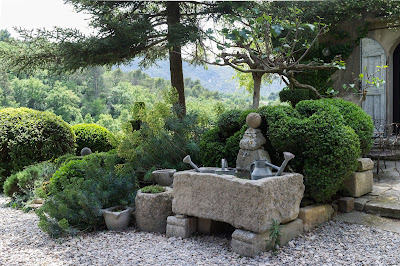It is not by chance that the 'Jardin Conservatoire des Plantes Tinctoriales' based itself in Lauris. Since the 16th century Lauris has been a centre for the production of natural dyes. It was the colour 'crimson' produced in the area that became so important. The Kermes insect that feeds on the sap of the Quercus coccifera (Kermes Oak) produces a red dye. After laying her eggs the female insect dies and dries out on the tree. The women in the area collected these dried up insects, they were then ground to a powder. It was a very lucrative industry at the time.
Kermes insect
Rubia tinctoria
Apart from the red dye, a yellow/greenish dye was produced from the berries of the Rhamnus spp (Buckthorn), a native to the region and
Rhamnus alaternus
a different yellow dye from the wood of the Cotinus coggygria (Smoketree), another native.
When the synthetic dyes started to appear as by-products of the petro-chemical industry the natural dye industry died. In the last few decades the interest in natural dyes has been revived, more and more people seem to be allergic to synthetic dyes.
We know so much more about plants nowadays, not just the botanical characteristics, with chemotaxonomy, we can classify plants according to their chemical composition.
The plants that produce the different coloured dyes are not just there for the colour, they have many additional benefits.
Thalictrum flavum produces a black dye
The yellow dye plants are the most wide-spread in the world. Yellow colourants contain flavonoids. Flavonoids have anti-inflammatory properties, they are captors of ultra violet rays and other radiation. For medicinal and dietary purposes, flavonoids are strong protectors against cellular aging.
A lot of trees ( in the bark) and plants contain tannin. Tannin has astringent properties, is used in the dyeing process as well as in the treatment of leather. The leather becomes soft and supple and does not spoil. Clothing that has been subjected to tannins in the dyeing process, protects our skin from infection in case of injury.
Before the introduction of Indigo (Indigofera tinctoria) from Asia, we used Isatis tinctoria as a blue dye.
Isatis tinctoria
Indigo produced a stronger blue and overtook Isatis tinctoria. Indigo was later replaced by synthetic dyes.
Indigofera tinctoria
By adding plants that have anti-oxidant properties to the Indigo, the blue dye contained in the roots of the plant become more soluble, no need to use sodium hydro-sulphite which leaves a toxic residue.
Indigo posseses a substance called 'indigotin'. Indigotin repels infra-red rays, insects and is anti-carcinogenic. Jeans are made of a material called Denim. The word 'jeans' comes from 'Gêne' (Genoa) and 'denim' is derived from 'de Nîmes'. Denim material was dyed blue with dye of the Indigo plant and was produced in Gêne and Nîmes. At the time little did the blue colour workers know, by wearing the jeans, it was protecting them from excessive temperatures and unwanted insects.
Most dyes need to be stabilised. Different methods are used eg. lime, urine, ash and mineral salts like iron and aluminium salts.
Bibliography: Literature supplied by the Conservation of Natural Dye Plants.
Jardin La Louve
Sue with Mme Sylvie Verger
The garden was designed by Nicole de Vésian, a fabric designer and stylist at Hermès. When she bought the house there was no garden to speak off, just a green hillside. She decided to create a garden of mostly evergreen shrubs, many native to the region and sculpture them into shapes, although the overal design is formal, she was very clever in making her garden flow into the landscape beyond.
Very few flowers are used, the overal impression is of a green foliage garden. In total there are 5 terraces, the whole plot is 1600 m2.
The lavender field with clipped and normal lavenders



























No comments:
Post a Comment